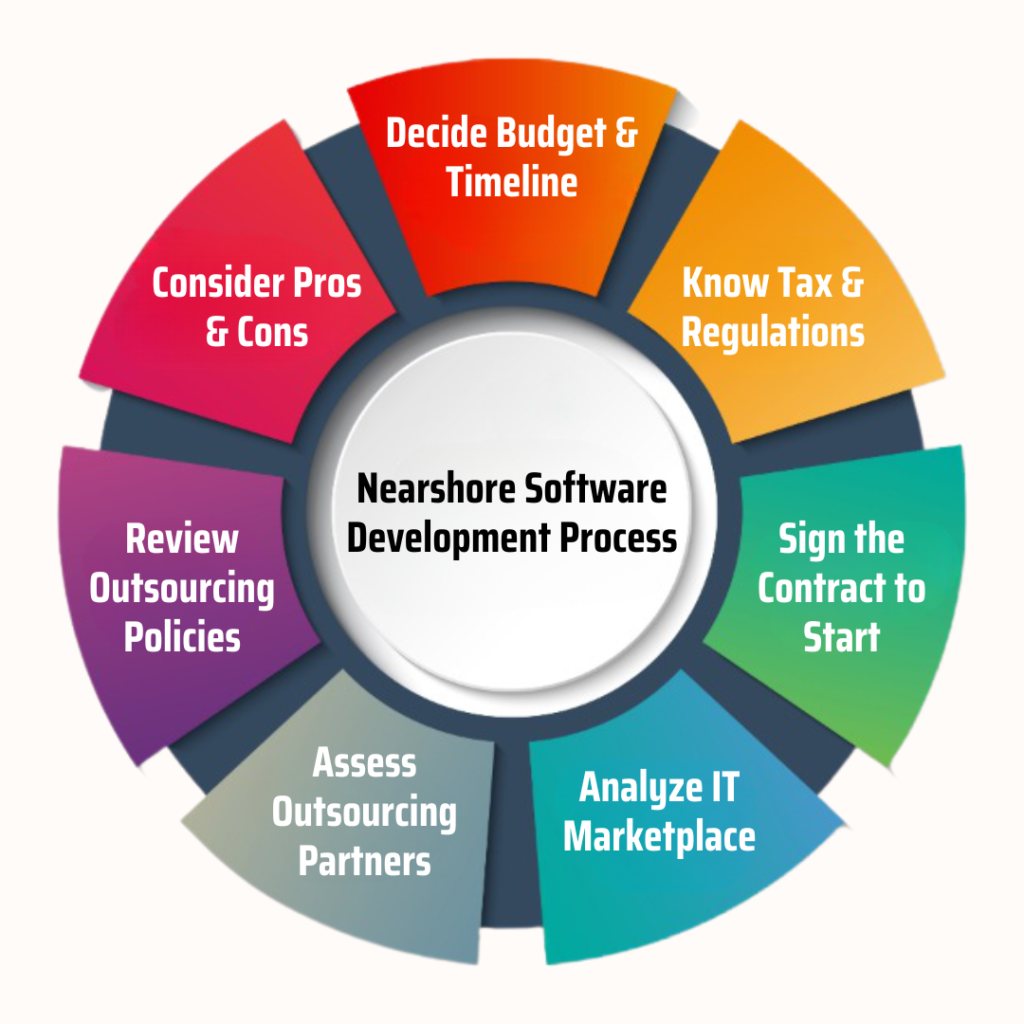Nearshore software development team emerges as a crucial aspect in the tech industry, offering a strategic approach to software development that maximizes efficiency and effectiveness. This article delves into the key components of building and managing a nearshore team, shedding light on the nuances of this innovative practice.
Setting up a nearshore team involves careful planning and understanding of the unique dynamics involved in working with a geographically close yet culturally distinct team. As businesses increasingly turn to nearshore outsourcing for their software development needs, exploring the intricacies of managing such a team becomes imperative for success.
Introduction to Nearshore Software Development Team
A nearshore software development team refers to a group of software developers located in a neighboring or nearby country to the client’s location. This model combines the advantages of outsourcing with proximity, making communication and collaboration easier compared to offshore teams located in distant countries.
Concept of Nearshore Outsourcing in Software Development
Nearshore outsourcing in software development involves hiring a team of developers in a country that shares a similar time zone, cultural values, and language proficiency with the client. This approach allows for real-time collaboration, efficient communication, and better alignment with the client’s business goals.
Benefits of Having a Nearshore Software Development Team
- Cost-effectiveness: Nearshore teams often offer competitive rates compared to in-house development teams, providing cost savings without compromising on quality.
- Cultural alignment: Working with a nearshore team can result in better cultural alignment, leading to smoother communication, understanding, and a shared work ethic.
- Time zone advantage: Similar time zones between the client and the nearshore team facilitate real-time collaboration, reducing delays in communication and project delivery.
- Talent pool access: Nearshore locations often have a diverse talent pool of skilled developers, offering a wider range of expertise and experience for the project.
Setting Up a Nearshore Software Development Team

When it comes to setting up a nearshore software development team, there are several key steps to consider. This process involves selecting the right team, establishing communication channels, and ensuring smooth collaboration between onshore and nearshore teams.
Key Steps in Setting Up a Nearshore Software Development Team
- Define project requirements and goals: Clearly Artikel the scope of the project, expected deliverables, and timelines to ensure alignment between both teams.
- Choose the right nearshore location: Consider factors such as time zone compatibility, cultural fit, language proficiency, and technical expertise when selecting a nearshore location.
- Establish effective communication channels: Utilize collaboration tools, regular meetings, and project management software to facilitate seamless communication between teams.
- Build a strong team structure: Assign roles and responsibilities clearly, define reporting structures, and promote a collaborative team environment.
- Ensure legal and security compliance: Address any legal requirements, data security concerns, and intellectual property protection to mitigate risks.
Comparison with Setting Up an Offshore Team
- Proximity and time zone: Nearshore teams are geographically closer, leading to overlapping working hours and easier coordination compared to offshore teams in distant locations.
- Cultural alignment: Nearshore teams often share similar cultural norms and practices, making it easier to work together compared to offshore teams with significant cultural differences.
- Cost considerations: While both nearshore and offshore teams offer cost advantages, nearshore teams may have slightly higher rates but lower travel expenses and better communication due to proximity.
Key Considerations for Selecting a Nearshore Software Development Team
- Technical expertise and experience: Look for a team with relevant skills, industry experience, and a proven track record of successful projects.
- Communication and language proficiency: Ensure that team members have strong communication skills in a common language to facilitate effective collaboration.
- Cultural fit and work ethic: Consider cultural similarities, work ethics, and team dynamics to ensure a seamless integration with your existing team.
- Time zone compatibility: Choose a nearshore location with a time zone that allows for sufficient overlap in working hours for real-time communication.
- Legal and security compliance: Verify that the nearshore team complies with legal regulations, data protection laws, and security measures to safeguard your project.
Managing a Nearshore Software Development Team
Effective communication is key when managing a nearshore software development team. Clear and frequent communication helps in aligning goals, expectations, and priorities. It is crucial to establish regular meetings, utilize collaboration tools, and encourage open channels for feedback.
Strategies for Overcoming Language and Cultural Barriers
- Provide language training: Offer language classes or resources to team members to improve communication skills.
- Embrace cultural differences: Foster a culture of inclusivity and respect for diverse backgrounds within the team.
- Utilize translation tools: Use tools like Google Translate or professional translation services for written communication.
- Clarify expectations: Ensure that all team members have a clear understanding of project requirements and objectives.
Tools and Technologies for Managing a Nearshore Team, Nearshore software development team
- Project management software: Platforms like Jira, Trello, or Asana can help in assigning tasks, tracking progress, and managing deadlines.
- Communication tools: Utilize tools like Slack, Microsoft Teams, or Zoom for real-time communication and virtual meetings.
- Version control systems: Implement tools like Git for code collaboration, versioning, and tracking changes.
- Screen sharing and video conferencing: Use tools like Skype or Zoom for screen sharing, code reviews, and virtual stand-up meetings.
Collaboration and Team Dynamics in Nearshore Development: Nearshore Software Development Team

Collaboration within a nearshore software development team is crucial for the success of the project. It involves effective communication, sharing of ideas, and working together towards a common goal. Without proper collaboration, the team may face challenges that can hinder productivity and quality of work.
Challenges in Team Dynamics
- Lack of Communication: Physical distance in a nearshore setup can lead to miscommunication or delays in sharing important information.
- Cultural Differences: Different cultural backgrounds within the team can result in misunderstandings or conflicts if not properly addressed.
- Time Zone Variations: Working across different time zones can make it challenging to schedule meetings or coordinate tasks effectively.
- Lack of Trust: Building trust among team members who are geographically dispersed can be difficult, impacting the overall team dynamics.
Strategies for Fostering a Cohesive Team Environment
- Utilize Collaboration Tools: Implementing tools like Slack, Zoom, or Trello can facilitate communication and collaboration among team members.
- Establish Clear Communication Protocols: Set guidelines for communication channels, response times, and meeting schedules to ensure everyone is on the same page.
- Encourage Team Building Activities: Organize virtual team building activities to strengthen relationships and build trust among team members.
- Promote Cultural Understanding: Take the time to learn about each team member’s cultural background and encourage an inclusive environment that respects diversity.
- Regular Feedback and Check-ins: Conduct regular check-ins to provide feedback, address any issues, and ensure everyone feels heard and supported.
Conclusive Thoughts

In conclusion, a nearshore software development team presents a compelling solution for companies seeking to optimize their development processes. By leveraging the benefits of nearshore outsourcing and implementing effective communication strategies, businesses can foster a collaborative and productive environment within their software development teams.
Embracing the challenges and opportunities that come with nearshore development can lead to enhanced innovation and success in the digital landscape.
FAQ Insights
What is the main difference between nearshore and offshore software development teams?
Nearshore teams are geographically closer to the client’s location, facilitating better communication and collaboration compared to offshore teams located in distant time zones.
How can language and cultural barriers be overcome when working with a nearshore team?
Effective communication tools, language training, and cultural sensitivity workshops can help bridge the gap and promote cross-cultural understanding within the team.
What are some key considerations to keep in mind when selecting a nearshore software development team?
Factors such as language proficiency, technical expertise, cultural alignment, and time zone compatibility should be carefully evaluated when choosing a nearshore team for software development projects.
